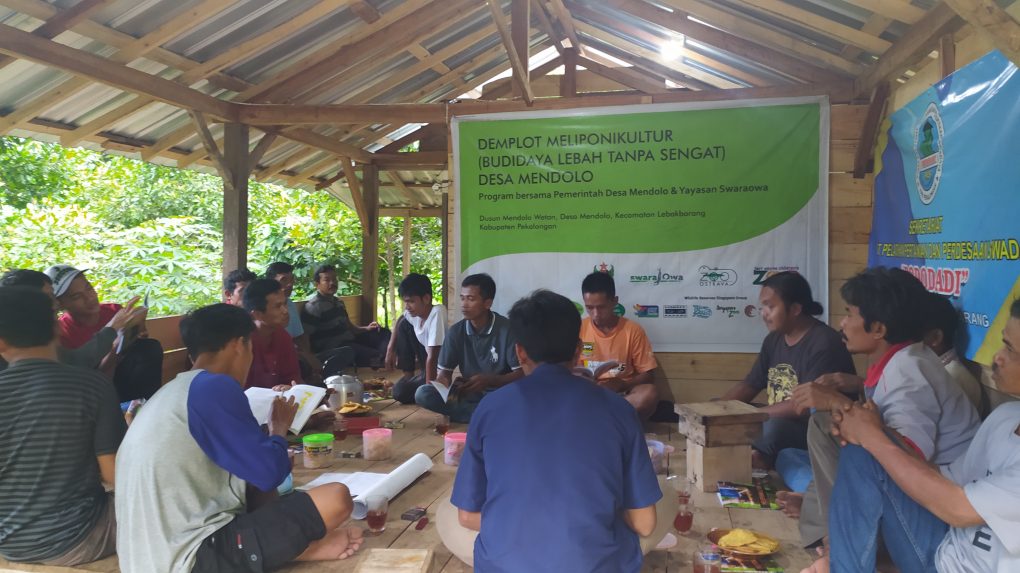Beekeeping has been named by the UN’s Food and Agriculture Organization (FAO) as one of the best sources of livelihood for communities in forested areas. Beekeeping provides two types of benefits that complement each other, the first economic, via the sale of the products thus generated, and the second ecological, by bees helping with pollination. For this reason, SwaraOwa have made promoting beekeeping one of our priorities for those communities living around the habitat of the Javan gibbon in Petungkriyono and Lebakbarang Districts, Pekalongan Regency, Central Java.
In Mendolo Village (Lebakbarang District), stingless bee honey farming – otherwise known as meliponiculture – has had a presence for a few years now. It all started with efforts to catalogue local bee species, which formed the basis for work on demonstration plots and on local outreach to explore the feasibility of keeping stingless bees in the area. Over the past year, several villagers have started rearing these bees, especially the species Heterotrigona itama.
On March 25, 2022, SwaraOwa was assisted by the Young Farmers’ Association (Paguyuban Petani Muda, PPM) Mendolo in conducting a training session on stingless bee honey farming for the residents of Mendolo. It had originally been scheduled for the previous year, but the pandemic caused delays. A total of 21 villagers took part in the event, which comprised interactive discussions about the techniques used in keeping stingless bees and the residents’ progress with their bee colonies.
Rohim, one of the locals who took part, said that the main problems he faced was bee colonies losing their vitality and not yielding honey that could be harvested immediately. “I’d tried moving the bee colony several times but ended up failing. The bees seem to have all flown off,” he said, opening the discussion. Several other villagers faced the same problem.
When the time came for the successful breeders to share their experiences, a lively discussion revealed that the culprit behind weakened colonies proved, in most cases, to be mistakes made when relocating the bees. “It is not that the whole colony had flown off, they were just short of winih (worker bees, ed.). This means that the bees hadn’t been relocated properly,” said Tarjuki, who, in the meantime, has succeeded in raising about 25 stingless bee colonies. Moving colonies inappropriately causes many worker bees to be unable to find their way home.
Aside from how colonies are moved around, the location of hives is also crucial. The ideal location is shady, but not densely packed with vegetation. Sunlight must still be able to reach the hive and there has to be enough air circulation so as not to trigger the growth of fungi that can harm the bees. On the other hand, if the vegetation is too sparse, the bees will be prone to attack by swallows and other birds.
Beekeepers should check on their bee colonies at least once a week. This is important, because nuisance species such as beetles, spiders and black ants have to be promptly removed to prevent them from attacking the colony and disrupting the supply of honey. Also, several kinds of parasite can destroy bee colonies and cause beekeeper huge losses.
Tarsono, another beekeeper, talks about his experiences from the previous season. He emphasises that only reasonable amounts of honey should be harvested to still leave the colony with a sufficient supply of food. This is especially relevant in the lead-up to the rainy season, when the flowers that the bees feed on become scarce. The attendees were encouraged to plant a variety of plants that bloom throughout the year. These flowers can help the bees tide over their ‘famine’ months.
The participants then looked at how to design the ideal beehive. The brood box for laying eggs is 15x15x15 cm. On top of it, a topping is installed as the honey compartment. By separating the brood and honey boxes, honey can be harvested without disturbing the bee colony too much. Harvesting should be done with an electric suction device to maintain cleanliness. This will also speed up honey production because honeycombs are not taken away and the bees can reuse the material.
At this event, SwaraOwa distributed practical manuals on stingless beekeeping. This book summarises the knowledge we had gained by doing research on demonstration plots over the past few years, supported by data from various sources. We hope for this book to serve as an additional reference for the community, so that they can continue developing the beekeeping industry they have pioneered.
Ultimately, this training session has equipped the Mendolo beekeepers with essential knowledge on how to prepare themselves for the dry season this year. It is then that the forest flowers bloom. If the villagers succeed in this year’s harvest, honey season will soon be upon us.
Written by : Sidiq Harjanto, Translated by T.T Chan


